*NURSING > DISCUSSION POST > NUR 603 My Week 2 Case Discussion Pulmonary Part 2 (All)
NUR 603 My Week 2 Case Discussion Pulmonary Part 2
Document Content and Description Below
NUR 603 My Week 2 Case Discussion Pulmonary Part 2 My Week 2 Case Discussion Pulmonary Part 2 follow up Visit physical exam and new diagnoses. Initial post includes the most likely diagnosis/spe... cific treatment plan given case study information supported by rationale and answers all questions presented in the case. Demonstrates course knowledge/assigned readings by: linking tests/interventions accurately to diagnoses, applies learned knowledge specifically to the symptoms and patient information using original dialogue **************************************** Hello Dr. Collins and class, Week 2 Case Discussion Pulmonary - Part 2 Michelle’s asthma is well controlled on Singular 10mg daily, and Albuterol as needed 1-2 times per week. She still continues to work in the bakery and presents to the clinic with an acute that started two days ago. Her respiratory rate is 24 and complains of mild shortness of breath with exertion. Her oxygen saturation (O2 Sat) was 94% on room air and complaints of inspiratory and expiratory wheezing. She states that her Temperature (Temp) days have been 101 to 102-degree Fahrenheit over the last 2days; and Influenza A is going around the bakery. Her cough is productive of white sputum. The exam findings show Michelle appears her stated age; is alert and oriented; calm but having mild work of breathing. Her current Heat Rate (HR) is 110 beats per minute (bpm), Blood Pressure (BP) is 150/85, Respiration Rate (RR) is 24, Temp is 101.4- degree Fahrenheit, and the apical rate is elevated at 110. Her cough is now dry and nonproductive. She has mild shortness of breath, a fair chest expansion, positive inspiratory and expiratory wheezes, no rales, no rhonchi. On auscultation, no thrills, gallops, or extra heart sounds are noted, so the physical exam is otherwise unremarkable. She was swabbed and tested positive for Influenza A (ICD-10-CM: J10.1). Based on these facts, aside from her chronic Asthma diagnosis, the most likely diagnosis for Michelle is Influenza A (Walia, Anderson, & Vincent, 2019). The Influenza A is a subgroup of the Influenza viral infection – a respiratory infection that that is manifested as fever, chills, aches and pains, cough, and sore throat (US Food and Drug Administration [FDA], 2017). 1. Determine appropriate treatment plan for Michelle. Discuss medications, doses, Durable Medical Equipment, and any testing, and apply these directly to her case. Provide your rationale with evidence. The appropriate treatment plan for Michelle revolves around the primary diagnosis of Influenza A. Usually Influenza A can be treated symptomatically. However, based on a history of having Asthma, it is important to treat the Influenza A with Oseltamivir (Tamiflu) to shorten the cause of the disease process in reducing the intensity of the disease on the patient (Doshi, Heneghan, & Jefferson, 2016). Thus, Tamiflu is a prescription medicine used to treat influenza in patients who are 2 weeks of age and older who have had flu-like symptoms for up to 2 days (FDA, 2017). Since the patient is within the two days’ time frame, Tamiflu will benefit Michelle in her recovery process. Because Michelle’s asthma is well controlled on the current treatment plan of a low-dose inhaled corticosteroid inhaler, Singular 10mg daily, and Albuterol as needed 1-2 times per week, I will maintain the same regimen for her Asthma. I will also add the following to her treatment plan to yield a more therapeutic health outcome. Imaging and Blood works: Chest Xray (CXR), and CBC Michelle stated in her description of the history of present illness that she had a productive cough, but in the assessment, she had a non-productive cough. So, I will obtain a chest x-ray to rule out Pneumonia (PNA). Also, I will check her complete blood count (CBC) and Complete Metabolic Panel (CMP) to rule out infection and to determine if the respiratory symptoms are of viral or bacterial etiology, especially since she's been febrile (Temp of 101 to 102-degree Fahrenheit) (Kennedy-Malone, Plank, & Duffy, 2019). Vaccination: influenza vaccine and Pneumococcal Vaccine Respiratory infections like influenza A are more serious for patients with asthma because they often can lead to PNA and/or acute respiratory disease (CDC, 2020). Also, patients who have asthma should also be up to date with pneumococcal vaccination to protect against pneumococcal diseases, such as pneumonia, bloodstream infections, and meningitis (CDC, 2020). So, if the patient, has not received her influenza vaccine and Pneumococcal Vaccine, then I will educate her on the importance of receiving it today (Weir, & Gruber, 2016; CDC, 2020). Durable Medical Equipment: Humidifiers Increased humidity may ease breathing in children and adults who have asthma or allergies, especially during a respiratory infection such as a cold (Asthma and Allergy Foundation of America [AAFA], 2015). However, a dirty mist or increased growth of allergens in the humidifier triggers or worsens asthma and allergy symptoms. 2. Decide whether she is safe to return home, include any prescriptions, or if a referral to a higher level of care is required. Discuss the criteria used to make your decision, how a referral is made, and defend your position. If the CXR indicated that the patient is positive for PNA, then I will treat the PNA outpatient if the CBC and CMP are normal and the patient is stable (Normansell, Sayer, Waterson, Dennett, Del Forno, & Dunleavy, 2018). However, I will use the CURB criteria to assess the relationship of the patients for confusion, urea, respiratory rate, and blood pressure, to the diagnostic tests (Liu et al, 2016). This will help in predicting the risk of mortality in the patient regarding community-acquired pneumonia and infection of any source (Kennedy-Malone, Plank, & Duffy, 2019). More so, I will use the CURB criteria to assess the relationship of the patients for confusion, urea, respiratory rate, and blood pressure, to the diagnostic tests and the need for hospitalization or not (Liu et al, 2016). So, the CURB criteria qualify patients if they have fever less than 37° C (98.6 degree- Fahrenheit); an albumin level less than 30 g/dL; confusion, BUN greater than 7 mmol/L, RR of at least 30 bpm, systolic BP less than 90 mm Hg or diastolic blood pressure less than or equal to 60 mm Hg, Pulse≥ 125 beats/min, and if the patient is 65years old or have qualifying comorbidities, etc (Liu et al, 2016, p. 3). A score of 2 indicates the patient has about a 10% risk of death and so should be considered seriously for hospital admission (Liu et al, 2016, p. 3). More specifically, elevated BUN levels (under the CMP) show a decrease in renal perfusion and indirectly predict the severity of pneumonia (Kennedy-Malone, Plank, & Duffy, 2019; Liu et al, 2016).). But if the CXR indicates the patient has PNA, the CBC, and CMP, and head to toe assessment indicates that the patient is not stable, then a referral to the Emergency Department (ED) is recommended for inpatient treatment with hydration and antibiotics (Normansell, Sayer, Waterson, Dennett, Del Forno, & Dunleavy, 2018). Nonetheless, should the CXR not show any infiltration, then PNA can be ruled out, and I can focus on just the Asthma and Influenza, in which case the Tamiflu and the home regimen for her asthma will take care of the symptoms. In Michelle’s case, the following will be her prescription: (Micromdedex, 2020) Tamiflu 75mg tablet Sig: Take 1 tablet twice daily by mouth for 5 days Disp: 10 Refill: 0 Albuterol (Ventolin) 90mcg oral inhalation (continued as previously prescribed) Sig: 2 puffs oral inhalation q 4-6hrs as needed Disp: 1 inhaler Refill: 0 Montelukast (Singular) 10mg tablet (continued as previously prescribed) Sig: Take 1 pill daily Disp: 30 Refill: 1 Referrals If the CXR had indicated the patient has PNA, the CBC, and CMP, and head to toe assessment indicates that the patient is not stable, then a referral to the Emergency Department (ED) would have been recommended for inpatient treatment with hydration and antibiotics (Normansell, Sayer, Waterson, Dennett, Del Forno, & Dunleavy, 2018). But since the patient’s assessment and diagnostic tests indicate the patient is stable enough to be treated outpatient (can go home), no referral is recommended at this time. But, if the condition gets worse and/or the patient does not respond to the treatment regimen, a referral to the pulmonologist will be made for further evaluation and treatment plan (Kennedy-Malone, Plank, & Duffy, 2019) 3. Discuss relevant education and follow-up plan. Education *Tamiflu is not a substitute for an annual flu vaccination, so, if the patient, has not received her influenza vaccine and Pneumococcal Vaccine, then I will educate her on the importance of receiving it today (Weir, & Gruber, 2016; CDC, 2020). However, the live attenuated influenza vaccine (LAIV) is contraindicated in adult patients who have asthma (Schub, & Ashely, 2018). *Humidifiers are great for Asthma patients: increased humidity may ease breathing in children and adults who have asthma or allergies, especially during a respiratory infection such as a cold (CDC, 2020). However, dirty mist or increased growth of allergens caused by high humidity can trigger or worsen asthma and allergy symptoms. *Life-style modification including avoiding smoking and/or secondhand smoke; having adequate sleep; increasing or maintaining activity level, and consuming a healthy nutrient-dense diet will complement the medications’ potential and yield optimum health outcomes. *Importance of adherence to the treatment regimen, monitoring and managing signs and symptoms of Asthma; and maintaining regular follow-ups with the provider(s) for disease control facilitates better control of the disease (Kennedy-Malone, Plank, & Duffy, 2019; AAFA, 2015). Follow-Up I will advise the patient to make a follow-up appointment to see me in the clinic in two weeks (Alhassan, Hattab, Bajwa, Bihler, & Singh, 2016). Thereafter, the follow-up appointment will be every three months as recommended CDC to evaluate the symptoms and/or the patients’ response to the treatment plan (Kennedy-Malone, Plank, & Duffy, 2019; Alhassan, Hattab, Bajwa, Bihler, & Singh, 2016). At the follow-up appointment, CMP or Basic Metabolic Panel may be ordered to evaluate for the patient’s response to the medication, and evaluate for side effects. References Alhassan, S., Hattab, Y., Bajwa, O., Bihler, E., & Singh, A. C. (2016). Asthma. Critical Care Nursing Quarterly. 39(2). 110-123. doi: 10.1097/CNQ.0000000000000104 Asthma and Allergy Foundation of America (AAFA). (2015). Asthma. Asthma and Allergy Foundation of America. Retrieved from https://www.aafa.org/asthma.aspx Centers for Disease Control and Prevention (CDC). (2020). Asthma. National Center for Environmental Health. Retrieved from https://www.cdc.gov/asthma/ Doshi, P., Heneghan, C., & Jefferson, T. (2016). Oseltamivir for influenza. The Lancet: London. 387(10014). 124-125. doi:10.1016/S0140-6736(15)01282-9 Kennedy-Malone, L., Plank, L. M., & Duffy, E. G. (2019). Advanced practice nursing in the care of older adults (2nd ed.). Philadelphia: F.A. Davis Company Liu, J. L., Xu, F., Zhou, H., Wu, X. J., Shi, L. X., & Falcone, M. (2016). Expanded curb-65: A new score system predicts severity of community-acquired pneumonia with superior efficiency. Scientific reports. 6(22911). 1-7. doi: 10.1038/srep22911 Micromedex (2020). IBM Watson Health, Greenwood Village, Colorado. Retrieved from https://www-micromedexsolutions- com.chamberlainuniversity.idm.oclc.org/micromedex2/librarian/CS/51309A/ND_PR/evidencexp ert/ND_P/evidencexpert/DUPLICATIONSHIELDSYNC/DAC90E/ND_PG/evidencexpert/ND_ B/evidencexpert/ND_AppProduct/evidencexpert/ND_T/evidencexpert/PFActionId/evidencexpert .GoToDashboard? docId=013460&contentSetId=100&title=Albuterol+Sulfate&servicesTitle=Albuterol+Sulfate&b randName=Proventil+HFA# (Links to an external site.) Normansell, R., Sayer, B., Waterson, S., Dennett, E. J., Del Forno, M., & Dunleavy, A. (2018). Antibiotics for exacerbations of asthma. Cochrane Database of Systematic Reviews. 2018(6). 1- 52. doi: 10.1002/14651858.CD002741.pub2 Schub, T., & Ashely, T., (2018). Asthma. CINAH. Nursing Guide: Quick Lesson. Retrieved from https://eds-a-ebscohost-com.chamberlainuniversity.idm.oclc.org/eds/pdfviewer/pdfviewer? vid=1&sid=763479dd-2ca8-43c3-956c-f1b3b3a69504%40sdc-v-sessmgr03 (Links to an external site.) US Food and Drug Administration (FDA). (2017). Tamiflu: Consumer questions and answers. Drug Safety and Availability: Postmarket Drug Safety Information for Patients and Providers. Retrieved https://www.fda.gov/drugs/postmarket-drug-safety-information-patients- and-providers/tamiflu-consumer-questions-and-answers#:~:text=Tamiflu%20is%20used%20to %20treat,for%20getting%20the%20flu%20vaccine. Walia, R. R., Anderson, T. K., & Vincent, A. L. (2019). Regional patterns of genetic diversity in swine influenza a viruses in the united states from 2010 to 2016. Influenza Other Respir Viruses. 13(3). 262-273. doi: 10.1111/irv.12559 Weir, J. P., & Gruber, M. F. (2016). An overview of the regulation of influenza vaccines in the united states. Influenza Other Respir Viruses. 10(5). 354–360. doi: 10.1111/irv.12383 ******************* I am sorry, I forgot to add the over the center medications for the fever and body ache that is associated with Influenza A. Please find below an addition to the medications(Micromdedex, 2020). Ibuprofen 200 mg tablet Take 1-2 tablets orally every 4-6 hours as needed for fever and pain Education Take ibuprofen with food. The maximum dose of Ibuprofen is 1200 mg/day. Do not take longer than 10 days unless directed by physician. Thank you. Gertrude. Reference Micromedex (2020). IBM Watson Health, Greenwood Village, Colorado. Retrieved from https://www-micromedexsolutions- com.chamberlainuniversity.idm.oclc.org/micromedex2/librarian/CS/E3A044/ND_PR/evidencexp ert/ND_P/evidencexpert/DUPLICATIONSHIELDSYNC/4772F2/ND_PG/evidencexpert/ND_B/ evidencexpert/ND_AppProduct/evidencexpert/ND_T/evidencexpert/PFActionId/evidencexpert.D oIntegratedSearch? SearchTerm=Ibuprofen&fromInterSaltBase=true&false=null&false=null&=null# ********************** Audrey Collins Thanks for your post Gertrude. You stated that upon auscultation, no thrills, gallops, or extra heart sounds are noted, so the physical exam is otherwise unremarkable. She was swabbed and tested positive for Influenza A. So what is your rationale for CXR and CBC? Reply Reply to Comment ***************** Dr. Collins, Thank you for the feedback. As previously established, Chest X-ray (CXR) is not a required diagnostic test for Asthma. Usually, patients who develop Influenza (Flu) recover in a few days up to two weeks, but others who develop complications such as Pneumonia (PNA) need urgent diagnosis and treatment to prevent life-threatening issues or death (American Lung Association, 2020). Michelle’s symptoms were indicative of Influenza A, but I wanted to rule out other possible differential diagnoses. Pneumonia is a viral or bacterial infection that inflames the alveoli, resulting in the fill up with fluid or pus that leads to symptoms such as a cough, fever, chills, and trouble breathing (American Lung Association, 2020). There are instances that the symptoms of pneumonia are so variable and similar to those of a cold or influenza (American Lung Association, 2020). In view of this, I ordered a chest CXR and complete blood count (CBC) to figure out if the patient only has Influenza A alone and/or a co-infection of flu virus like the PNA (Centers for Disease Control and Prevention [CDC], 2020). Thus, CXR looks for the location and extent of inflammation in your lungs, while the CBC helps evaluate the composition and concentration of the cellular components of blood - white blood cell (WBC) counts and red blood cell (RBC) counts. Thank you, Gertrude References American Lung Association. (2020). Pneumonia: Symptoms and diagnosis. Lung Health & Diseases. Retrieved from https://www.lung.org/lung-health-diseases/lung-disease- lookup/pneumonia/symptoms-and-diagnosis Centers for Disease Control and Prevention (CDC). (2020). Flu symptoms & complications. National Center for Environmental Health: Symptoms & Diagnosis. Retrieved from https://www.cdc.gov/flu/symptoms/symptoms.htm [Show More]
Last updated: 1 year ago
Preview 1 out of 13 pages
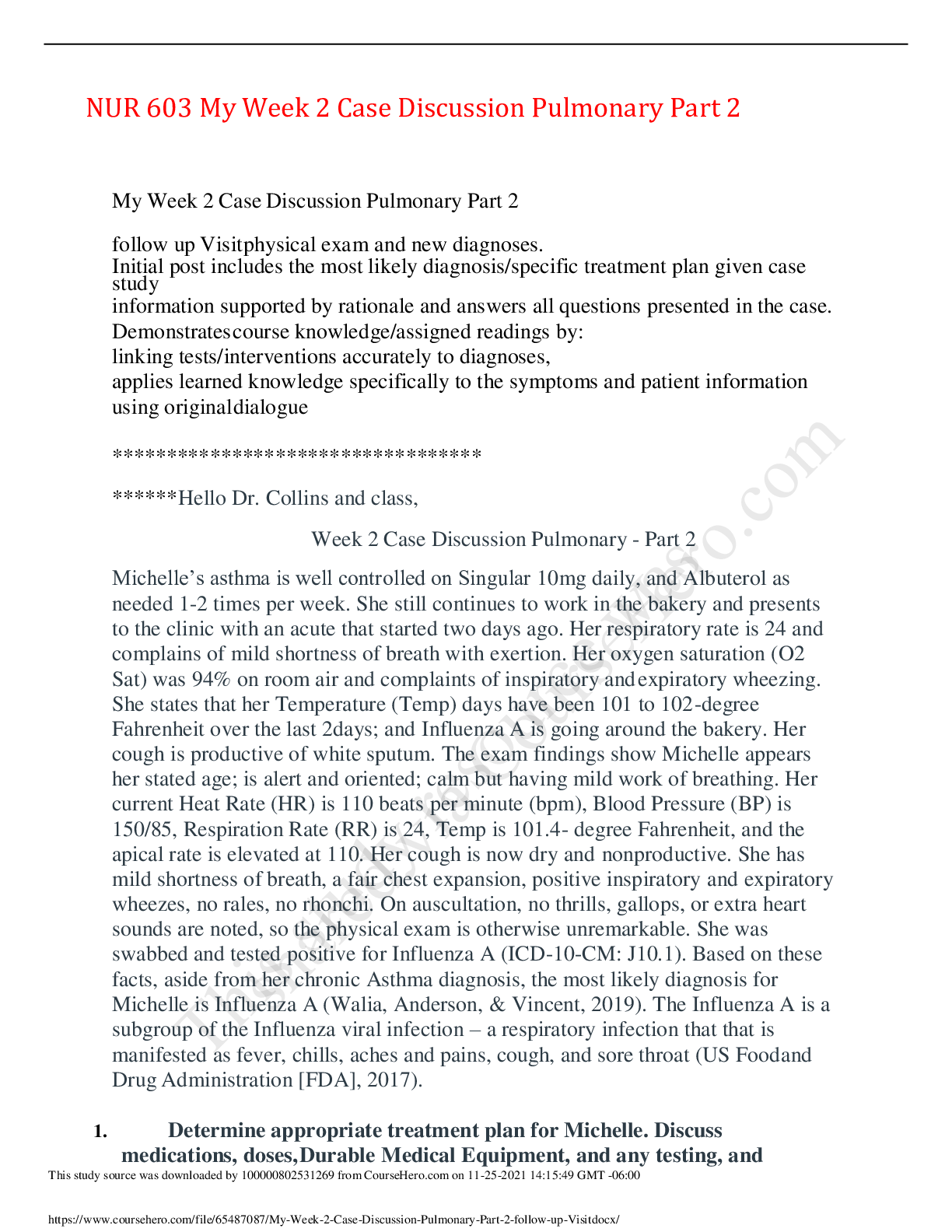
Reviews( 0 )
Document information
Connected school, study & course
About the document
Uploaded On
Nov 26, 2021
Number of pages
13
Written in
Additional information
This document has been written for:
Uploaded
Nov 26, 2021
Downloads
0
Views
42

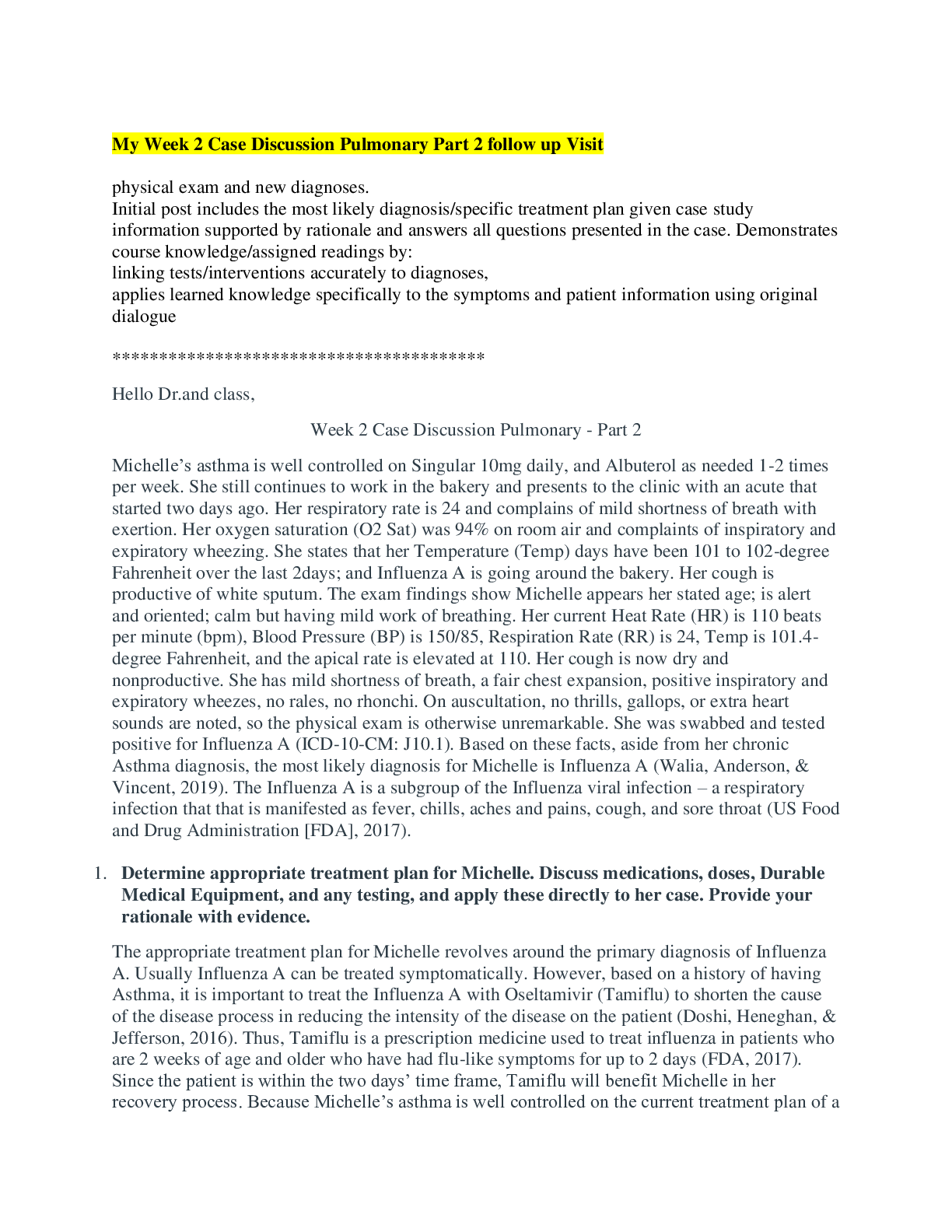
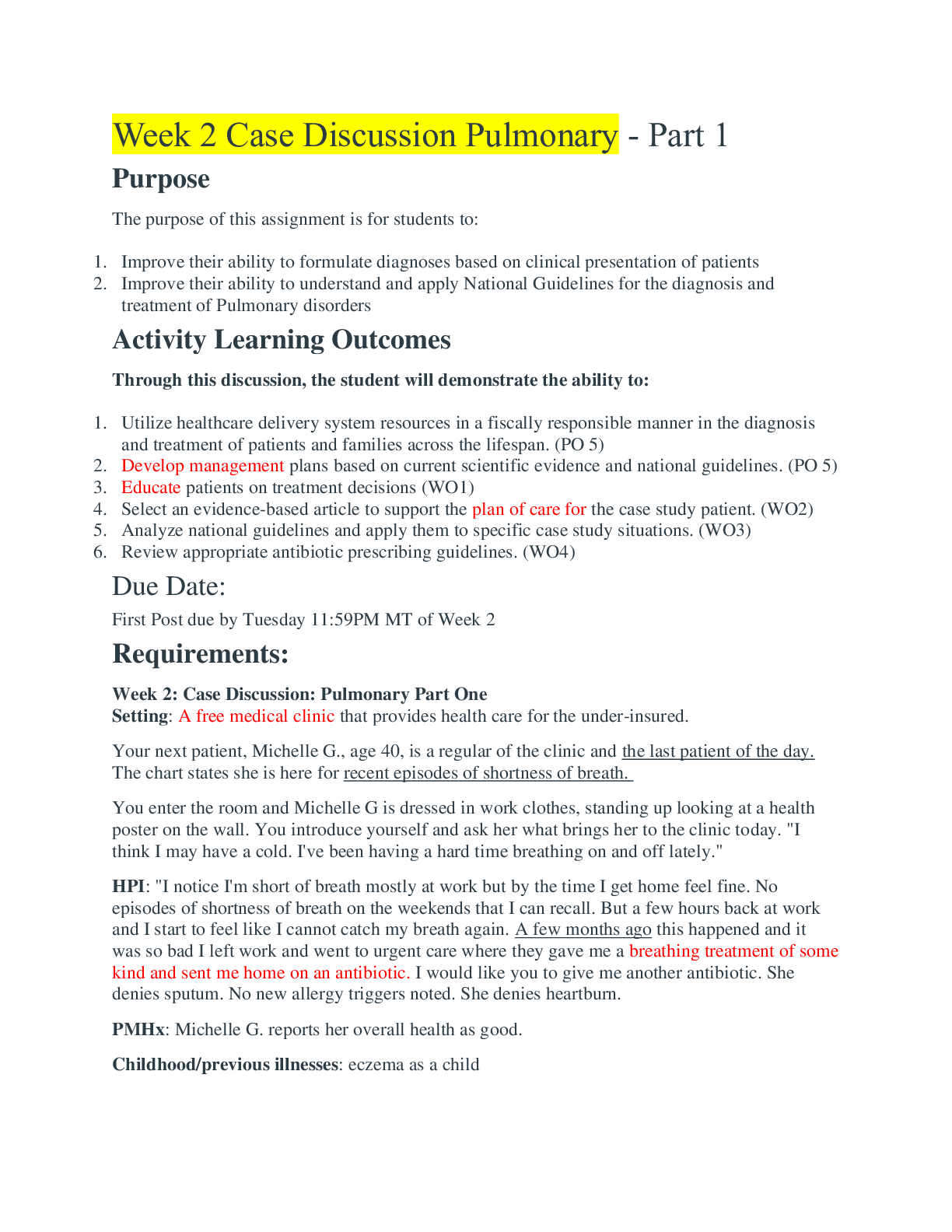
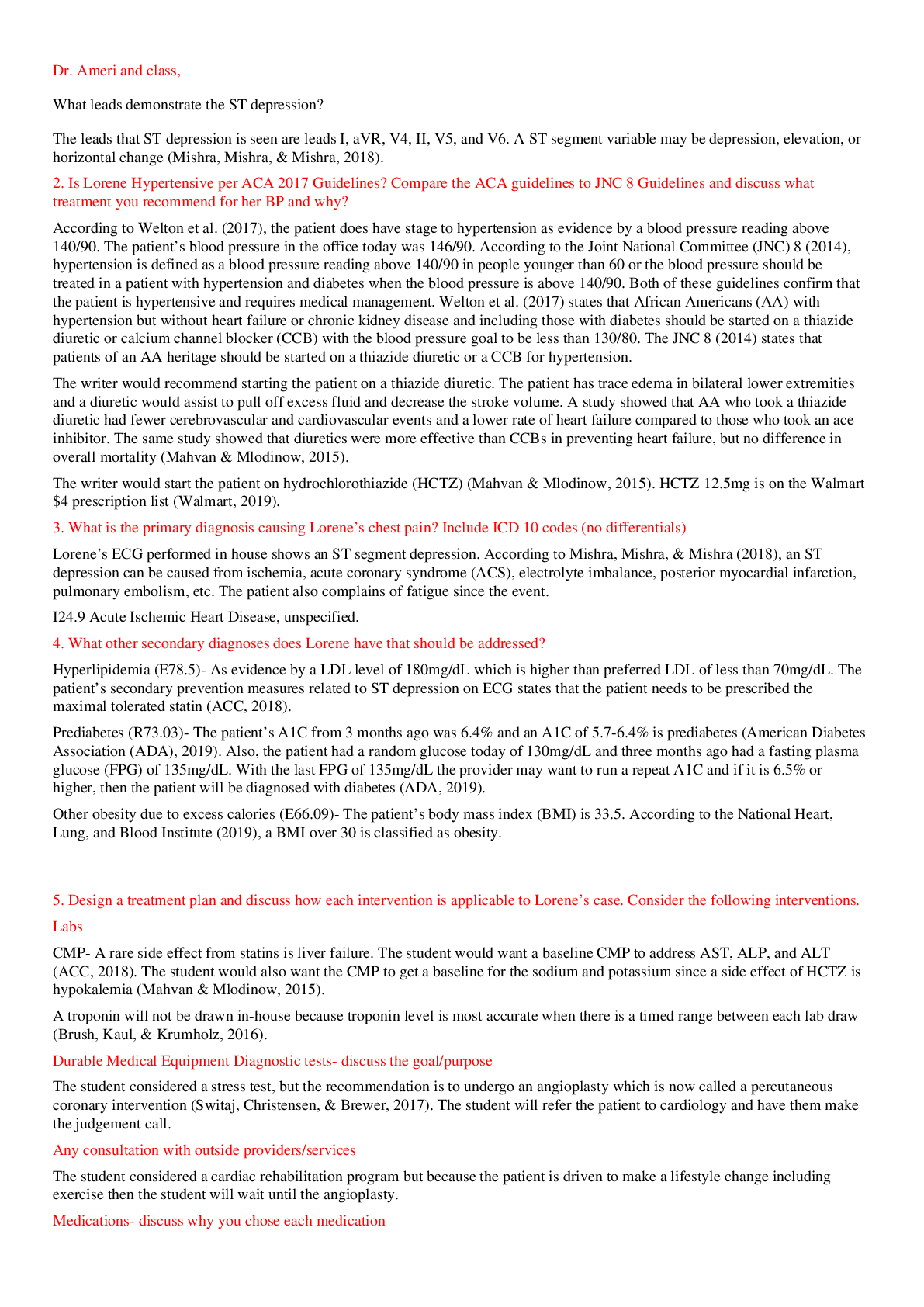

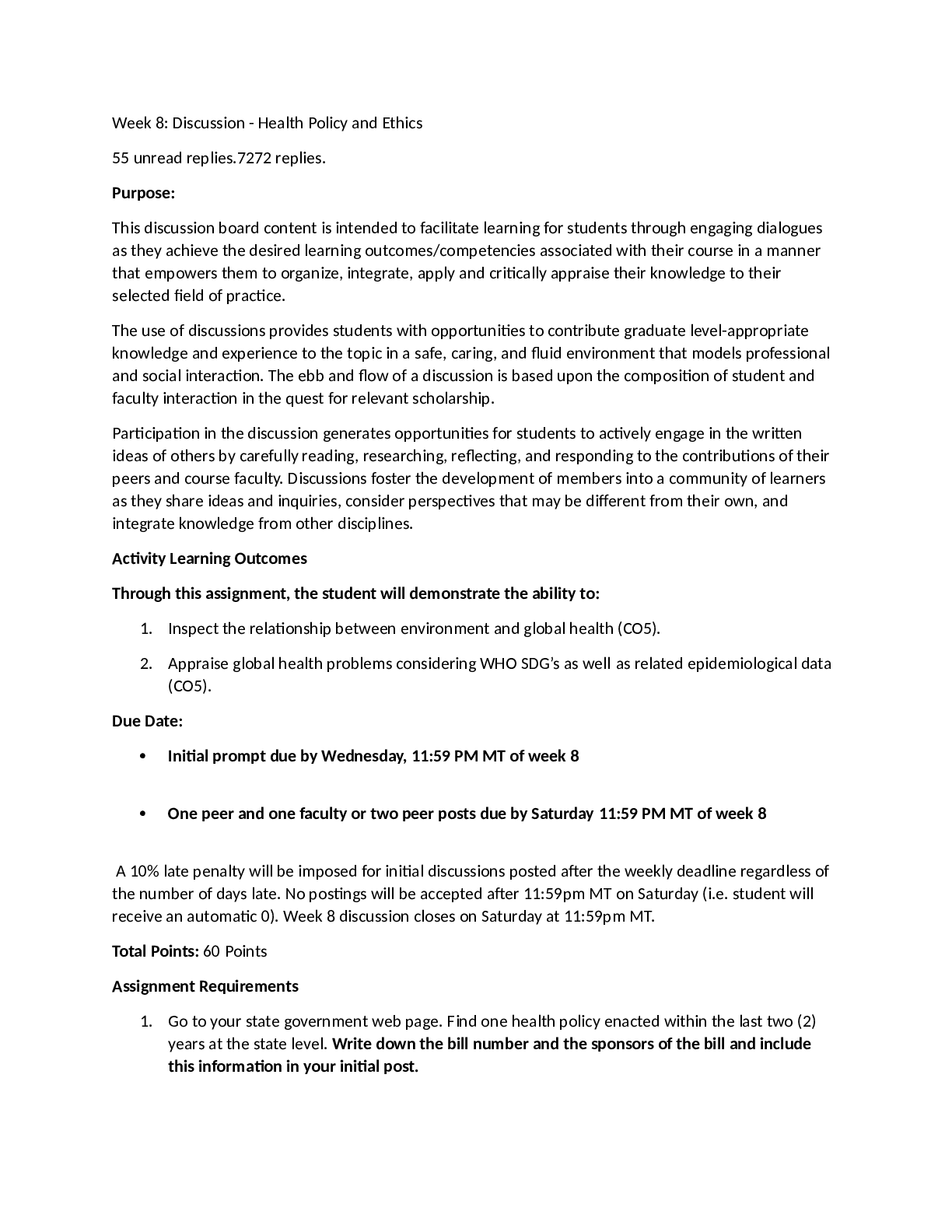
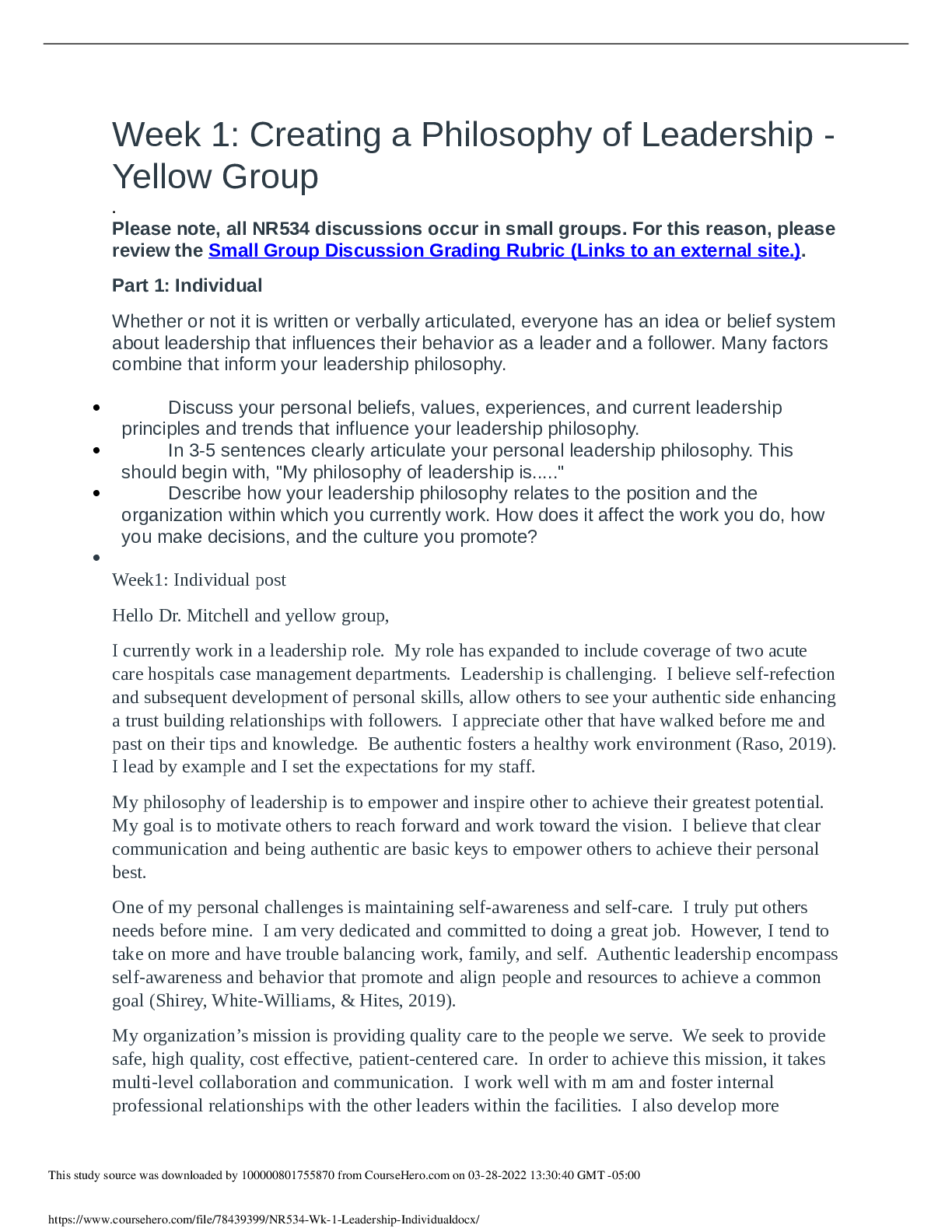


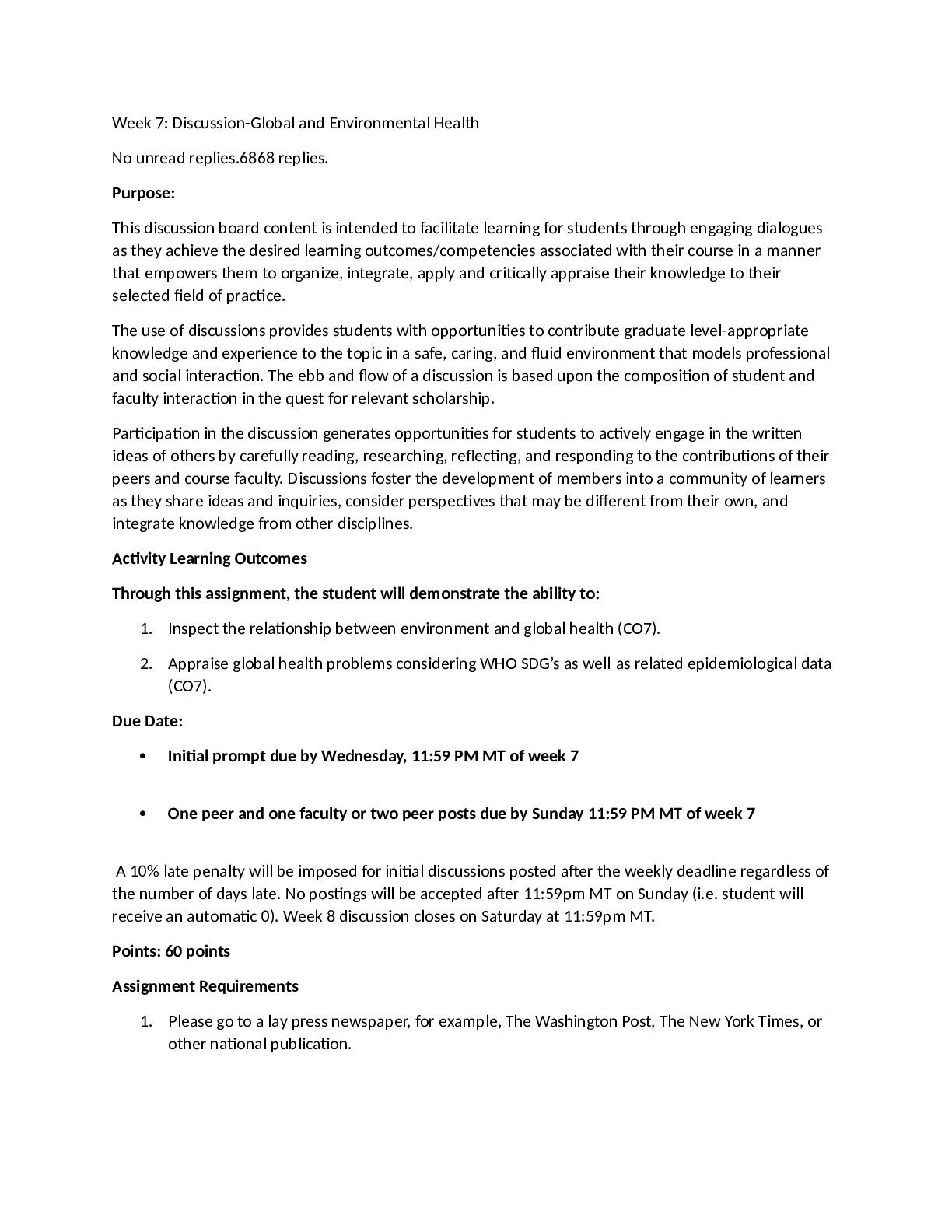

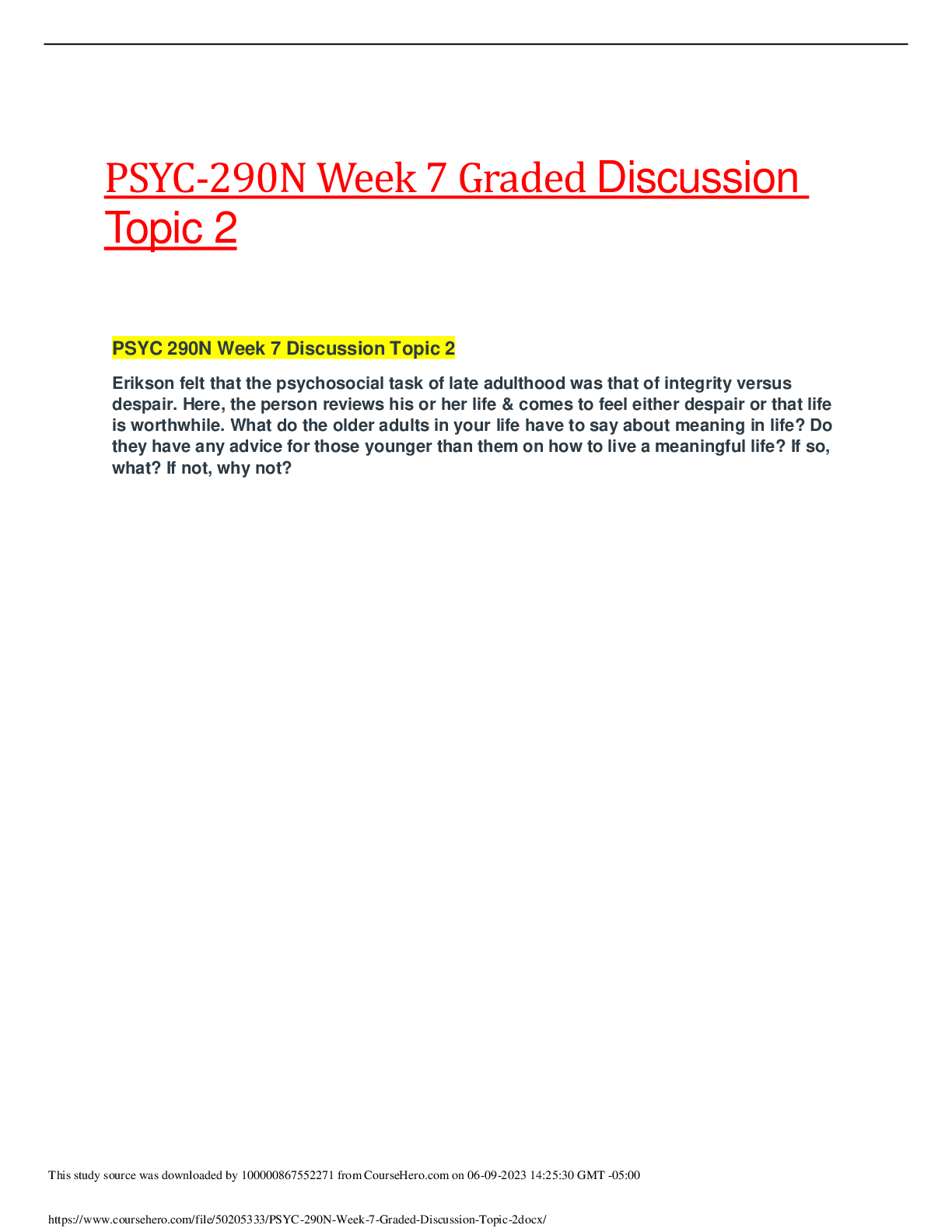
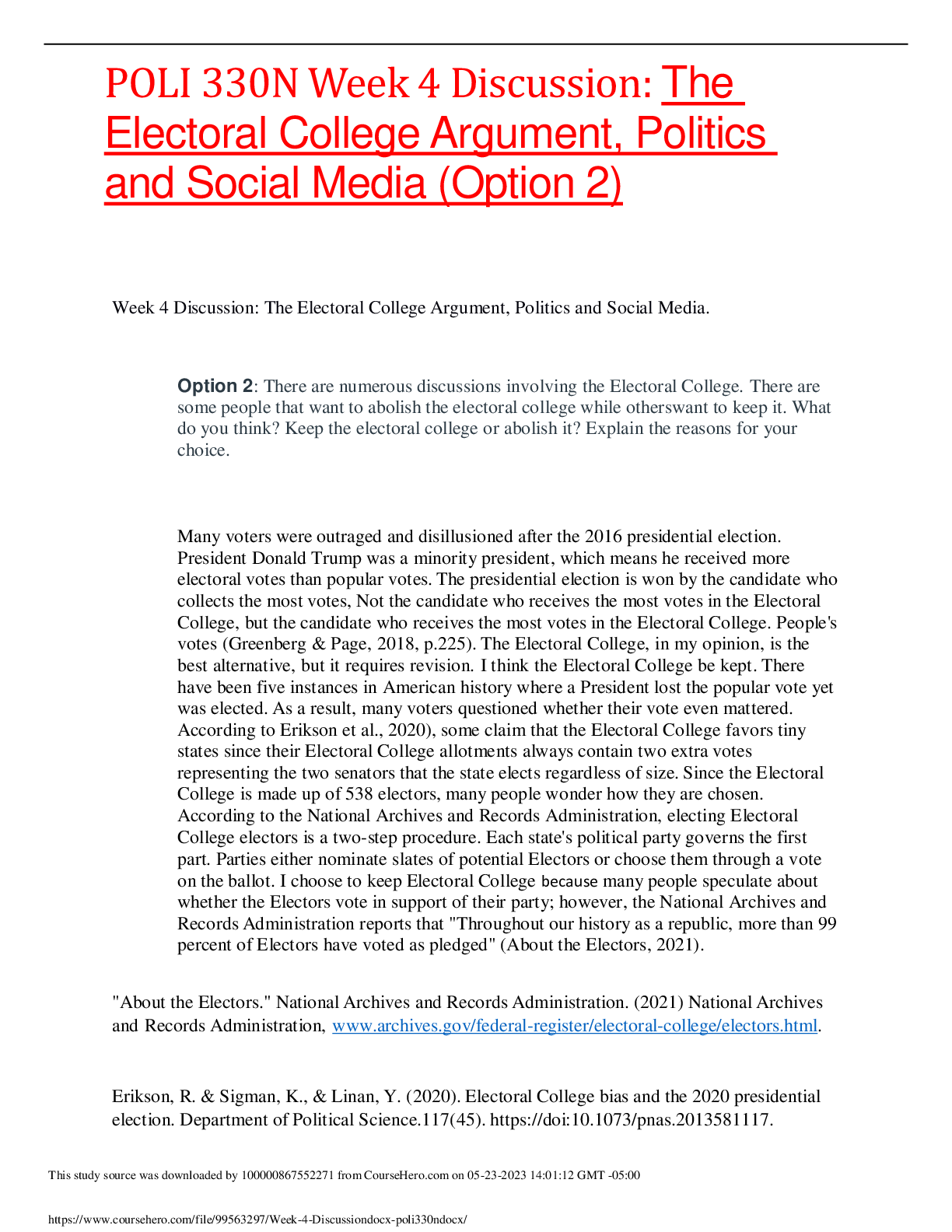

Growth and developmental patterns of toddlers.png)




